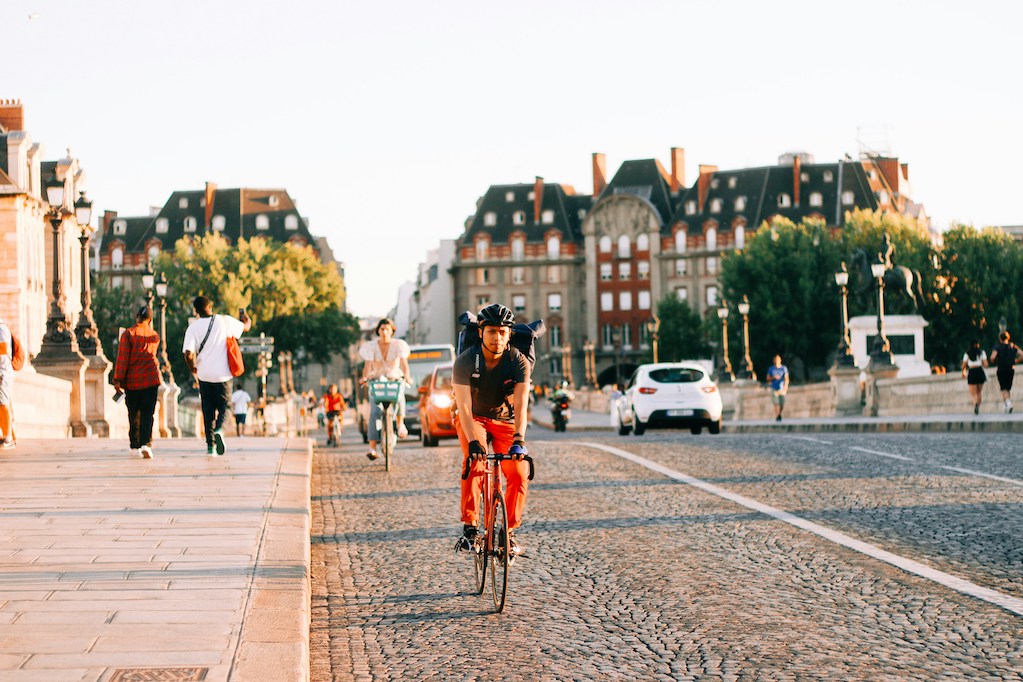Autumn Gear Guide
Find inspiration in our Gear Guide that will keep you out on your bike through wind or rain.
Download NowThere is a massive and dangerous heat wave spreading across large swaths of Eastern North America this week. Urban cycling during a heat wave can be a daunting and dangerous challenge, but with the right preparation and strategies, you can stay cool, safe, and enjoy your ride. Here’s a guide to help you navigate the […]
There is a massive and dangerous heat wave spreading across large swaths of Eastern North America this week. Urban cycling during a heat wave can be a daunting and dangerous challenge, but with the right preparation and strategies, you can stay cool, safe, and enjoy your ride. Here’s a guide to help you navigate the summer heat wave on your bike.
Before diving into the tips, it’s crucial to understand how heat affects the body. When you exercise, your muscles generate heat. Normally, your body cools itself through sweating, but in extreme heat, this process can become inefficient. High temperatures and humidity can overwhelm your body’s cooling mechanisms, leading to dehydration, heat exhaustion, and heat stroke. Symptoms of heat exhaustion include heavy sweating, weakness, dizziness, nausea, and headache. If left untreated, it can escalate to heat stroke, a severe condition characterized by confusion, rapid pulse, and high body temperature, which requires immediate medical attention.
Hydration is the cornerstone of safe cycling in hot weather. While water is essential, it’s not sufficient on its own when you’re sweating profusely. Electrolytes, which are lost through sweat, need to be replenished to maintain your body’s fluid balance. Sports drinks or natural alternatives that contain electrolytes are excellent for keeping you hydrated and preventing dehydration. Make it a habit to drink regularly throughout your ride, even if you don’t feel thirsty. Pre-hydrate by drinking water and consuming a light, balanced meal before you head out. Carry a water bottle throughout the day to ensure you’re well-hydrated when it’s time to ride, not when it’s too late.
Acclimatizing your body to high temperatures is crucial for maintaining performance and safety during hot weather rides. Start with low-intensity rides and gradually increase the duration and intensity over about ten days. This gradual exposure helps your body adapt by improving its cooling efficiency through sweating. Additionally, passive heat exposure methods, like spending time in a sauna or hot bath, can help your body get used to the heat without the physical strain of exercise.
Choosing the right clothing can make a significant difference in managing heat. Wear lightweight, breathable fabrics that wick away sweat and help keep your body cool. Light-colored clothing reflects more sunlight and absorbs less heat compared to dark colors. Consider investing in sun sleeves or jerseys with UV protection to shield your skin from harmful rays while keeping you cool. A well-ventilated helmet is also essential to allow airflow and help dissipate heat.

Cycling in a summer heat wave is possible with precautions
Eating the right foods before and during your ride is essential to maintain energy levels and prevent heat-related issues. Opt for light, easy-to-digest foods that won’t weigh you down. Fruits with high water content, like watermelon and cantaloupe, are excellent choices as they provide hydration and essential nutrients. After your ride, continue to hydrate with water and electrolyte-rich drinks. A recovery drink that combines protein and carbohydrates can help replenish your energy stores and aid muscle recovery.
Ensure your bike is in good condition before heading out. Check the tire pressure, brakes, and overall functionality of your bike to avoid any breakdowns in the heat. Carry a repair kit and know how to use it in case of emergencies. Additionally, equip your bike with a bell, lights, and reflectors to enhance visibility, especially if you’re riding early in the morning or late in the evening.
To better manage heat during your ride, consider the following strategies:
Finally, the most important tip is to listen to your body. Heat can quickly lead to exhaustion, dehydration, and heatstroke. If you start feeling dizzy, nauseous, or excessively fatigued, find a cool place to rest and hydrate immediately. Don’t push yourself too hard and be prepared to cut your ride short if necessary.
By following these tips, you can enjoy urban cycling even during the hottest days of summer. Stay hydrated, dress appropriately, plan your routes, and listen to your body to make the most of your rides while staying safe and comfortable.
Find inspiration in our Gear Guide that will keep you out on your bike through wind or rain.
Download Now
Leave a comment